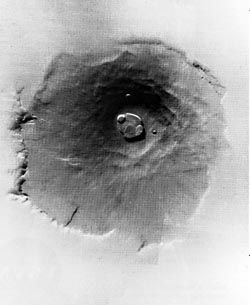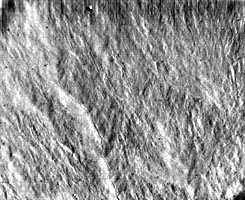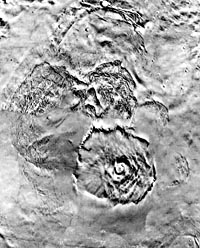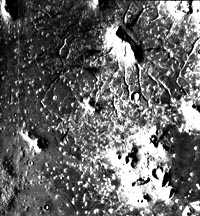 |
|---|
| Plate P-6 |
 |
|---|
| Plate P-6 |
The first systematic high-resolution imagery of all of Mars, from Mariner 9, showed that Martian geomorphology is far more complex and interesting than the Moon-like topography indicated by earlier missions. Only the most common of the many Martian landforms are treated in this and the next two Plates, beginning here with the largest volcano on Mars, Olympus Mons.
Lying on the Tharsis bulge, a large plateau, Olympus Mons is marked most obviously by its size (Meszaros, 1984). Although Alba Patera has a greater area, Olympus Mons, with a width of 650 km and a height of 26 km, leads in volume. Other members of the Tharsis volcanic province, (Figure P-6.1, from bottom: Arsia Mons, Pavonis Mons, and Ascraeus Mons) are similarly large compared to terrestrial counterparts; Ascraeus Mons, for example, covers about the same area as the basaltic Columbia Plateau, formed by many fissure eruptions.
| Figure P-6.1 | Figure P-6.2 |
|---|---|
 |
 |
Why are the Martian volcanoes so big? The answer is almost certainly something more fundamental than lower gravity or atmospheric pressure. Most authorities ascribe the difference to basic tectonic style. The absence of substantial strike-slip faulting, subduction, and folding indicates that Mars has not entered the plate tectonic stage (unless the Valles Marineris (Plate P-7) is considered to be made up of incipient rifts). If this interpretation is correct, there has been no major crustal motion on Mars, so that volcanoes stay fixed over their subsurface magma sources, unlike terrestrial oceanic volcanoes such as those of Hawaii. Their volcanic effluents can thus pile up into structures of immense size, rather than being distributed along chains.
The morphology of Olympus Mons is typical of basaltic shield volcanoes: a broad upward-convex construct similar to terrestrial examples such as Mauna Loa except for its size. The low slopes of its flanks, only a few degrees, imply formation by a very fluid lava such as basalt. A close look at these flanks (Figure P-6.2), in a Mariner 9 view covering an area 50 km wide, shows terrain identical in all major respects to fresh basaltic lava flows on Earth. The sinuous channel in this area resembles many collapsed lava tubes in terrestrial volcanic fields (Murray et al., 1980); the reader will find it interesting to compare this feature with Hadley Rille (Figure P-3.2). An important aspect of the Martian lava flows as seen here is that, where individual flows can be traced, they are generally much longer and wider than terrestrial flows, which generally do not go more than a few tens of kilometers from their source volcanoes (although fissure eruptions do). As discussed by Carr (1982), this characteristic is probably the result of very high effusion rates for Martian basalts.
| Figure P-6.3 | Figure P-6.4 |
|---|---|
 |
 |
Northwest and north of Olympus Mons is a large aureole of ridged terrain (Figure P-6.3). This terrain is one of the most mysterious physiographic features on Mars, for which a wide range of origins has been proposed. As summarized by Morris (1979), these include: (1) deeply eroded early lava flows, (2) eroded old shield volcanoes, (3) dissected ashflow tuffs, (4) magma-related crustal doming, fracturing, and erosion, (5) thrust sheets related to Olympus Mons, (6) subglacial lava flows, and (7) landslides. The ridged terrain is related to Olympus Mons in some way and is of roughly similar age, judging from impact crater counts (which must be used cautiously here because mass wasting could rapidly erode craters). Perhaps the most imaginative of the theories listed is that proposed by Hodges and Moore (1979), who find the ridged terrain similar to the table mountains of Iceland (Plate V-15). These consist largely of lavas and tuff breccias erupted under glacial ice several kilometers thick. Hodges and Moore further suggest that the unusual 5-km high scarp surrounding Olympus Mons expresses the former extent and thickness of this ice sheet, which confined the subaerial eruptions from the central vent.
The concept of Mars covered even partially with glacial ice is a fascinating one, but there is independent evidence for at least widespread subsurface ice in the form of very small Martian volcanoes (Frey and Jarosewich, 1982). As shown in Figure P-6.4, the northern plains contain thousands of subkilometer-wide cones with central craters. Although they resemble cinder cones, Allen (1979) and Frey and Jarosewich (1982) have shown that a more likely explanation is that these features are pseudocraters formed when lava flowed over water- or ice-saturated ground. Similar but somewhat smaller features are found in Iceland, where their origin is well established.
There is no good way to determine the absolute age of Olympus Mons, although the relative scarcity of impact craters suggests a low age. Wise (1977) has described the "crater number," the number of superposed impact craters greater than 1 kilometer wide per million square kilometers, as a convenient expression of the crater population. For a given flux of crater-forming objects, the crater number expresses the absolute age of a terrain; the problem is of course to find the correct flux for a given planet and to allow for crater destruction. Using Hartmann´s (1977) model, Carr (1982) estimates the age of Olympus Mons to be about 400 million years, although he cautions that this may be only the age of the youngest flows, the main structure possibly having grown over billions of years. Nevertheless, even a 400 million year old landform would be ancient by terrestrial standards; study of photographs from Earth-orbiting spacecraft by Lowman (1981) indicates that volcanoes in humid climates seldom survive as recognizable features much longer than about 1 million years. Olympus Mons is a physiographically youthful volcano dating from roughly the Silurian Period. Like the Moon, Mars has evolved geomorphically with incredible slowness by terrestrial standards. 72-H-716.
Continue to Plate P-7| Chapter 10 Table of Contents.| Return to Home Page| Complete Table of Contents|